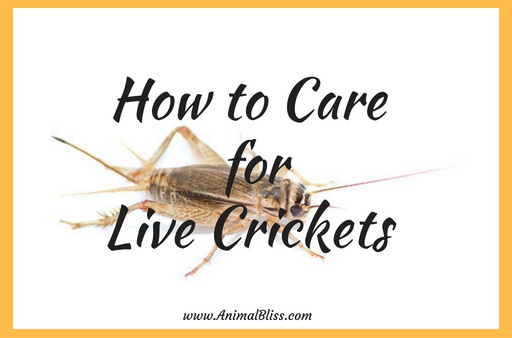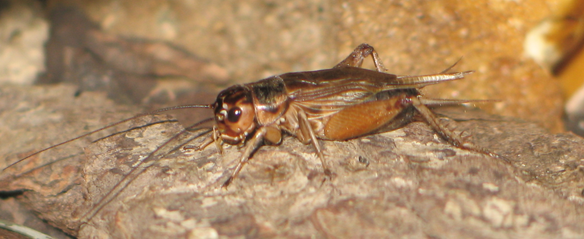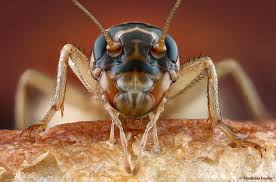Handling Crickets
For all you reptile owners out there, I’m sure you know how difficult it can be to keep your crickets alive long enough to feed your animal. More often than not, a good portion of them are dead either on arrival or soon after. The result is you have to throw out many dollars worth of the live feed. It’s not a good feeling, is it? Following is a post with tips on how to care for live crickets so that you never have problems with them.
So, unless you plan on breeding your crickets, you need to know how to care for live crickets from the time they arrive at your door. As soon as possible after your cricket shipment arrives, take them out of the box they came in; this can be tricky, and you’ll have to develop your system for this. Otherwise, you WILL have crickets running all over your house! Not a truly bad thing, it’s just that you didn’t order them to be your house pets.
I went out and bought a tall plastic storage container – one that the crickets can’t jump out of. They also can’t climb the smooth surface of the plastic. I cut out some rectangular shapes on either end and taped metal screening over the opening so that the crickets could breathe and have oxygen.
If possible, don’t use any type of cover on the cricket container. Fresh, moving air will drastically increase the cricket’s lifespan. But we understand this may come with undesirable results, so a screen is the 2nd best option.
Keep the egg crates that came in the shipping boxes. Crickets always seek out dark spaces, and these are perfect for that. I also save toilet paper rolls or paper towel rolls for this reason as well. I supply plenty of dark space so that they’re not all clamoring for the same little areas.
Quantities of 1,000 crickets or more will need at minimum a 10-gallon container. (Crickets over ½” will need a 15+ gallon container with a depth of at least 15”.)
RELATED:
Bearded Dragon Care Sheet: How to Care for Your Pet Dragon
You can also buy Cricket Keepers at various pet stores. These come with tubes that the crickets can climb up in and are quite handy. However, if you have too many crickets in one tube, the ones at the end of the tube tend to die quickly. They get squashed lack oxygen, or can’t get to their food or nutrition, etc. The larger ones are supposed to be good for 200 crickets, but I find that a little too crowded.
Crickets can endure heat but are sensitive to colder temperatures. Winter shipments of crickets that appear lifeless are usually in a state of hibernation. Allow your crickets to warm up to room temperature for two or three hours before passing judgment on their condition. The cold temperatures can cause the crickets to become dormant, but after a few hours at room temperature, they usually perk right up.
The ideal range of temperature for your live crickets should be between 70° – 75° F, which is critical for proper function of crickets’ metabolism and immune system. Do not expose crickets to direct sunlight, high humidity, or drafts of cold air.
Keep your cricket containers clean at all times to ensure a healthier, longer life for your crickets. Keep your tank free of all dead crickets and waste material. Rinse it out with hot water or a mild bleach solution.
Pesticides or cleaning solutions, other than a mild bleach solution, should NEVER be used to clean your cricket container. Make sure your container is dry before adding more crickets as can drown in very little water. If you keep up with this simple maintenance, your crickets should live to be a lasting supply of live feed for your pet.
Feeding and Watering
Crickets are relatively easy to keep. They need basic food and water to survive, and when well taken care of, they will remain a good, active supply of live crickets to feed your pet for weeks. Always have on hand a dry food source and a separate water source for your crickets.
You can buy dry cricket food, available at all pet stores and from live cricket retailers, or you can feed them oatmeal or cornmeal from your kitchen. Other food sources are chicken mash or chick starter, available at feed stores. Be sure to change the food out weekly, or as needed. Do not let it get damp or moldy.
UPDATE:
Chicken mash is a good food source. But to simplify it, you can use a piece of wheat bread. Bread is great and easy to find, and always on hand.
Having water available to your crickets at all times is crucial. One of the quickest ways to kill crickets is to take them away from their water source, but also know, again, that crickets drown very quickly, which is why we do not recommend you have an open pool of water near your crickets. Your “watering device” can be a simple damp sponge sitting on a shallow plate, but check it daily to make sure it is damp! Oranges are great sources of water.
You can also buy “cubes” (see Update below) which are known as Water Bites. Or, you can buy Total Bites which is a combination of both water and nutrients for your crickets. You will often receive your shipment of crickets with either Water Bites or Total Bites, as well as a chunk of potato.
UPDATE:
The problem we find with those water cubes is that they are packed with too many nutrients and supplements. because of that, they don’t hydrate your crickets as well as advertised.
Potatoes serve as both a water and a food source. However, do not use potatoes as a daily food source for your crickets because potatoes can cause a damp environment that if left for more than three days can be harmful to our species of cricket.
I hope you have learned how to care for live crickets! Good luck!
Original Source: Armstrong Crickets
UPDATES PROVIDED BY The Critter Depot
MY QUESTION FOR YOU TODAY:
Do you have pet reptiles in your home? What are they?
*** Please leave a comment below and remember to share. ***
- Mindful Travel With Your Dog This Holiday Season - December 23, 2019
- A-Z of Australia’s Endangered Wildlife - December 20, 2019
- Teaching Your Kids How to Walk the Dog Safely - December 2, 2019




Thank you for posting this information. I very much appreciate it!
IN addition to a pair of Moroccan Uromastyx (vegetarians) I have five Ackie Monitors (Varanus Acanthurus) and have been visiting the pet shops several times a week for 100 to 150 crickets at a time. I do keep food and water available for them, but I have a high mortality rate with pet store crickets, even as quickly as I use them. The advice about the “Cricket Keeper” tubes is spot-on, if I keep the tubes out, I get much better longevity.
I have just started ordering crickets in bulk and am researching cricket care articles and this is one of the best ones.
Just getting started with a lizard for my great granddaughter.
Wow! So much to learn!
Bought crickets, mealy worms, and cockroaches 😳.
Appreciate your information on care of crickets.
Great article. Thank you for sharing all this info!
I have just read this article and was wondering would you suggest getting small ones or big ones as I’m looking for them to live for a long time
thanks
How old do crickets get to?
I have 2 leopard geckos and am currently learning to keep crickets alive to have a food source for them.
Thanks for the info. I started raising crickets today. It’s my first time trying to grow crickets. I haven’t heard them chirp yet. Do you know if I buy crickets from different places and they are different species will they still breed? Will they fight more? If my bug has been dead less then 24 hours can it still be safe to give to my dragon? What can I do with the dead crickets besides throwing them away?
This was really helpful, thanks!
For their water, would a pompom work?
I have a cricket named cricky I love him soooooooooooooooo much
That’s cool. How old is your cricket?
We just started breeding crickets and for those about keeping them alive. It’s been true trial and error. We keep our crickets at 84degrees, we feed them chicken layer mesh, and the ultimate key to survival is water. We use cricket quencher, a blue gel we buy from flukers. Or on chewy.com. plenty of space is also important. And some sliced up potatoes.
Shaun, I imagine breeding crickets can be tricky. Do you have a big operation, or is it a cottage industry? Either way, good luck to you and thanks so much for visiting Animal Bliss. Peace
I have a Leopard gecko and I buy my crickets 4 dozen at a time. I use Cricket quencher and bread squares for food and water. My crickets never seem to last more than 5 days and I am throwing more than half of them away. What am I doing wrong???
Del, it’s really unpredictable how long crickets will last once you get them. It depends on the age of the crickets, their storage and care before you purchased them, their origin, etc. I’m sure you aren’t doing anything wrong and I understand your frustration. Buy them locally if you can, and buy the small ones (the youngest) ones. If you buy the medium or large, they’re already more than partway through their life span. If you are ordering them by mail, unpack them the minute they get home. Good luck! I hope this helps.
I keep 4 tarantulas and a dictator scorpion. Honduran Curley hair, King baboon, Chilian rosehair, and cobalt blue.
I can’t seem the keep the crickets alive 🙁
That’s quite a collection you have there, Mike. I wouldn’t think any of those would have crickets in their diet but I know nothing about them. Thanks for visiting Animal Bliss today.
Hi, I was wondering when I bought my crickets they asked me small or large? Does this mean age? Also if all my crickets are staying together, will they naturally try to make more crickets?
Kelsa, small or large crickets refer to their size. You should never feed a bearded dragon anything wider than its head, so a baby beardie should only have the small ones. You don’t want them to choke. On that note, it also refers to their age. An adult beardie can eat the medium or large crickets. Large crickets are older, so they won’t last as long as the medium. Mediums may last a couple of weeks, depending on their care.
Crickets will breed, but only under specific conditions, which is another topic altogether. For the amount of time you’ll have your crickets, don’t expect to hear the waa-waa of little wee ones. 🙂 Thanks for your visit and questions!
I read the article “How to keep crickets alive”. But my crickets die after 3 days anyway. I have a tarantula, he loves crickets. Last time I got abt 2 dozen. Within 3 days everyone of them gone. Help! Don’t know what to do.
Theresa, your crickets should last longer than 3 days. Are they able to have oxygen, food, and hydration? Are you keeping them in a cricket keeper or container with holes, cricket food and orange pellets? (They also need hiding places, like toilet paper rolls.) Are you buying the adult crickets? If so, try getting juveniles instead. They should last longer because they’re not already reaching the end of life. If you’re doing all these things anyway, maybe you need to find a new supplier. Let me know how it goes! Thanks for visiting my blog.
Jeanne I couldn’t agree more with you about the importance of providing water. Most cricket tubs seem to come with basic food in (for example bran) but no water.
A source of moisture – like the sponge you mention or even some fruits/vegetables like sliced carrot – can help to keep crickets alive indefinitely.
Infact, I’ve even been successful breeding them from time to time, which can come in handy from a budget perspective! 🙂
Hey Paige! I’m glad you visited my blog today. I see it’s your first time. I order my crickets 500 at a time, so I make sure they get everything they need to last weeks. I’ve only got the one Bearded Dragon, so I need to make them last quite a while. I see you’ve written a “Beginners Guide to Keeping Pet Stick Insects”. Interesting. Did you see that I wrote an article on that as well? I’ll go read yours now. Thanks so much!